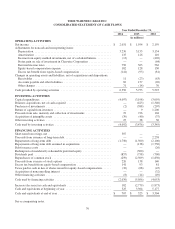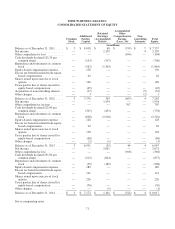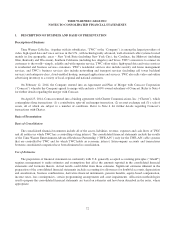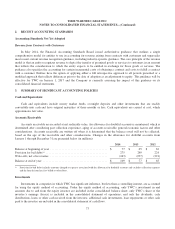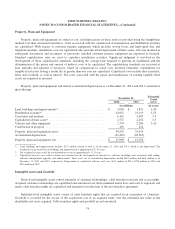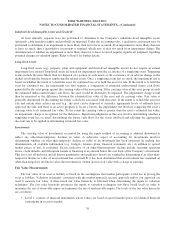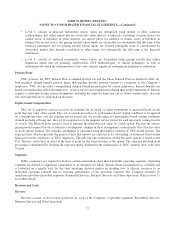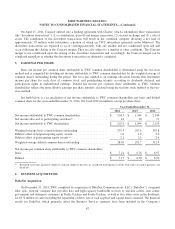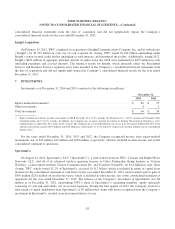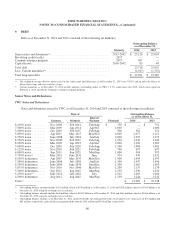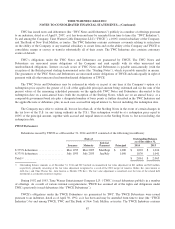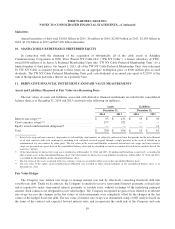Time Warner Cable 2014 Annual Report Download - page 88
Download and view the complete annual report
Please find page 88 of the 2014 Time Warner Cable annual report below. You can navigate through the pages in the report by either clicking on the pages listed below, or by using the keyword search tool below to find specific information within the annual report.TIME WARNER CABLE INC.
NOTES TO CONSOLIDATED FINANCIAL STATEMENTS—(Continued)
Multiple-element Transactions
Multiple-element transactions involve situations where judgment must be exercised in determining the fair value of
the different elements in a bundled transaction. As the term is used here, multiple-element transactions can involve
(i) contemporaneous purchases and sales (e.g., advertising services are sold to a customer and at the same time
programming services are purchased) and/or (ii) sales of multiple products and/or services (e.g., video, high-speed data
and voice services are sold to a customer).
Contemporaneous Purchases and Sales
In the normal course of business, TWC enters into multiple-element transactions where the Company is
simultaneously both a customer and a vendor with the same counterparty. For example, when negotiating the terms of
programming purchase contracts with cable networks, the sale of advertising to the same cable network may be negotiated
at the same time. Arrangements, although negotiated contemporaneously, may be documented in one or more contracts.
The accounting policy for each transaction negotiated contemporaneously is to record each element of the transaction
based on the respective estimated fair values of the products or services purchased and the products or services sold. The
judgments made in determining fair value in such transactions impact the amount of revenue, expenses and net income
recognized over the respective terms of the transactions, as well as the respective periods in which they are recognized.
In determining the fair value of the respective elements, quoted market prices (where available), historical
transactions or comparable cash transactions are considered. The most frequent transactions of this type involve funds
received from vendors. Cash consideration received from a vendor is recorded as a reduction in the price of the vendor’s
product unless (i) the consideration is for the reimbursement of a specific, incremental, identifiable cost incurred, in which
case the cash consideration received would be recorded as a reduction in such cost, or (ii) an identifiable benefit in
exchange for the consideration is provided, in which case revenue would be recognized for this element.
With respect to vendor advertising arrangements being negotiated simultaneously with the same cable network, an
assessment is performed to determine whether each piece of the arrangement is at fair value. The factors that are
considered in determining the individual fair value of the programming vary from arrangement to arrangement and
include (i) the existence of a “most-favored-nation” clause or comparable assurances as to fair market value with respect
to programming, (ii) a comparison to fees paid under a prior contract and (iii) a comparison to fees paid for similar
networks. In determining the fair value of the advertising arrangement, advertising rates paid by other advertisers on the
Company’s systems with similar terms are considered.
Sales of Multiple Products or Services
If sales contracts are entered into for the sale of multiple products or services, the standalone selling price for each
deliverable in the transaction is evaluated. For example, video, high-speed data and voice services are sold to subscribers
in a bundled package at a rate lower than if the subscriber purchases each product on an individual basis. Revenue
received from such subscribers is allocated to each product in a pro-rata manner based on the standalone selling price of
each of the respective services on an individual basis. As another example, if a subscriber moves from a bundled package
containing two services to a bundled package containing three services, the increase in the total revenue received is not
attributed to the additional service. Rather, the total revenue received from such subscribers are allocated to each of the
three products in a pro-rata manner based on the relative selling price of each of the respective services on an individual
basis.
80


